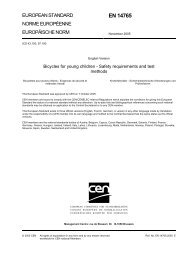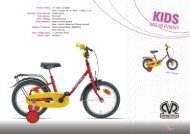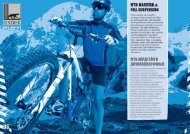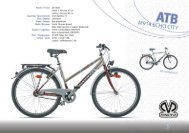EN 14766:2005 - 64_e_stf - Baltik vairas
EN 14766:2005 - 64_e_stf - Baltik vairas
EN 14766:2005 - 64_e_stf - Baltik vairas
- No tags were found...
Create successful ePaper yourself
Turn your PDF publications into a flip-book with our unique Google optimized e-Paper software.
<strong>EN</strong> <strong>14766</strong>:<strong>2005</strong> (E)Key1 Rigid mount2 Minimum insertion depth4.14.6.3 Test methodFigure 50 — Saddle and seat-pillar clamp – fatigue testInsert the seat-pillar to its minimum insertion depth (see 4.14.3) in a rigid mount representative of that on thebicycle and with its axis at 73° to the horizontal. Mount the saddle on the seat-pillar, adjust the saddle to have itsupper surface in a horizontal plane and to be at its maximum rearward position in the clamp, and tighten the clampto the torque recommended by the bicycle manufacturer. Apply a repeated, vertically-downward force of 1 000 Nfor 200 000 cycles, in the position shown in Figure 50 by means of a suitable pad to prevent localised damage ofthe saddle cover.The test frequency shall not exceed 4 Hz.4.14.7 Seat-pillar – fatigue test4.14.7.1 GeneralIn the following test, if a suspension seat-pillar is involved, the test shall be conducted with the suspension systemadjusted to give maximum resistance.4.14.7.2 RequirementWhen tested by the method described in 4.14.7.3, there shall be no fractures or visible cracks in the seat-pillar.If the pillar is a suspension type, the design shall be such that in the event of failure of the suspension system, thetwo main parts do not separate nor does the upper part (i.e. the part to which the saddle would be attached)become free to swivel in the lower part.For carbon-fibre seat-pillars, the peak deflection during the test shall not increase by more than 20 % of the initialvalue.77







